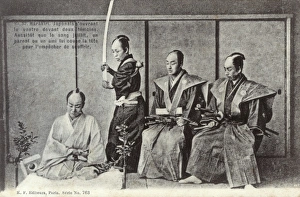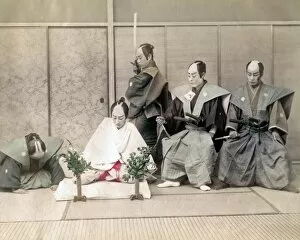Seppuku Collection
"Seppuku: The Ancient Ritual of Honor and Sacrifice in Japan" Step back in time to witness the solemnity and significance of seppuku
All Professionally Made to Order for Quick Shipping
"Seppuku: The Ancient Ritual of Honor and Sacrifice in Japan" Step back in time to witness the solemnity and significance of seppuku, a ritualistic form of suicide practiced by samurais in feudal Japan. This staged ceremony, known as harakiri, holds immense cultural importance and is captured through various artistic depictions. One such portrayal is "Mori Ranmaru Killed in Battle at Honnoji, " an engraving from 1886 by Yoshifuji. It showcases the tragic fate of Mori Ranmaru during a historical event. Another artwork, "Act 9 (Kyudanme)" by Ando Hiroshige from the series "The Revenge of the Loyal Retainers (Chushingura), " offers a glimpse into this ancient practice's theatrical representation. As we delve deeper into history, we encounter an engraving titled "The War in Eastern Asia" created by a Chinese artist. This piece provides insight into how seppuku was perceived beyond Japanese borders. "The Hara-Kiri, " an unknown creator's work from 1891, sheds light on the intricacies involved in this profound act. Additionally, staged performances are highlighted through artworks like "Hari-kiri. " Renowned artists Katsushika Hokusai and Utagawa Kuniyasu contribute their talents to capture pivotal moments within seppuku ceremonies. Their works include acts four ("Yodanme") and six ("Rokudanme") from the famous play Kanadehon Chushingura. These captivating depictions serve as reminders that seppuku was not merely an act of self-destruction but rather a demonstration of unwavering loyalty and honor among samurais. Through these artworks spanning different periods, we gain insights into this ancient tradition that continues to intrigue us today.











